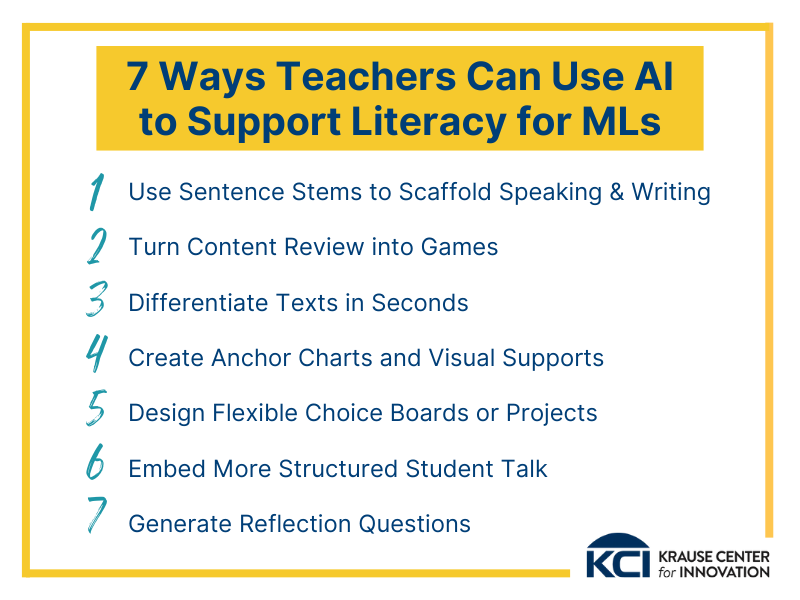October 21, 2025
This post draws inspiration from the book Artificial Intelligence, Real Literacy by Paul Matthews and Jason Gulya, whose work on AI and evidence-based literacy practices shaped much of what’s shared here. All of these strategies that support multilingual (ML) students are really just great strategies for teaching all students!
What if the best way to help multilingual learners thrive with AI is to keep focusing on what great teachers already do?
Supporting multilingual superheroes isn’t about trendy tools or tech hype. Teachers support them with clear language, meaningful practice, and creating a space where students feel seen and supported.. AI can help us do that, if we use it intentionally. Here is how all teachers can use AI to help provide and strengthen access to the curriculum with AI by their side.
1. Use Sentence Stems to Scaffold Speaking & Writing
AI can quickly generate sentence starters for any subject or skill level. These frames reduce the stress of open-ended tasks and help students focus on ideas instead of perfect grammar.
Prompt:
“Give me sentence stems for high school ML students to use when discussing _____. Include simple, moderate, and complex versions.”
Sentence stems build confidence and fluency while reinforcing academic language.
2. Turn Content Review into Games
Review doesn’t have to mean boring worksheets or silent quizzes. AI can help you turn academic content into games that build vocabulary, confidence, and collaboration.
Prompt:
“Turn these 10 vocabulary words into a team-based review game for multilingual learners that includes speaking and movement.”
You can also ask AI to generate partner games, matching cards, or Would You Rather prompts tied to your unit content. Canva Code can even create an interactive game for students to play!
3. Differentiate Texts in Seconds
No more spending hours rewriting the same article at three different reading levels. AI can adapt any reading for access and voice.
Prompt:
“Simplify this article to a 5th grade level. Keep key ideas. Add bullet points for a summary.”
Put all versions on one page and let students choose the one that fits best. This normalizes differentiation and promotes choice.
4. Create Anchor Charts and Visual Supports
ML students thrive when key vocabulary and concepts are reinforced visually. Use AI to brainstorm language-rich visuals that support your content.
Prompt:
“Suggest 5 anchor chart ideas to help multilingual students understand and use figurative language.”
You can also introduce students to AI by having them generate images for vocabulary flash cards or writing prompts using key terms.
5. Design Flexible Choice Boards or Projects
Choice helps students connect to learning in ways that feel personal and empowering. AI can help you design tasks that work across language levels and still meet standards.
Prompt:
“Create a project-based choice board for multilingual learners studying ______. Include speaking, writing, and creative expression options.”
Ask AI to scaffold each option with sentence starters or visual examples.
6. Embed More Structured Student Talk
Structured talk routines give students time to think, speak, and connect in supported ways. Use AI to help you strategically embed more speaking opportunities into each class.
Prompt:
“List 5 academic discussion routines with directions and sentence frames for multilingual learners.”
Try these formats:
- Think-Pair-Share
- Lines of communication
- Trading cards
- Talking chips
- Agree, agree, disagree
AI can tailor prompts to your topic or student interests and adjust complexity for different proficiency levels.
7. Generate Reflection Questions
AI can help you create quick, accessible reflection questions that spark insight and build metacognition.
Prompt:
“Give me 3 short reflection questions for multilingual learners after a small group discussion on identity.”
These questions help students make meaning, not just complete tasks.
So, Why Use AI?
It’s not about being techie. It’s about doing the basics better.
AI makes it easier to bring strong, evidence-based practices like scaffolds, retrieval practice, and student voice to more students, more often. That’s how we support learning and belonging.


